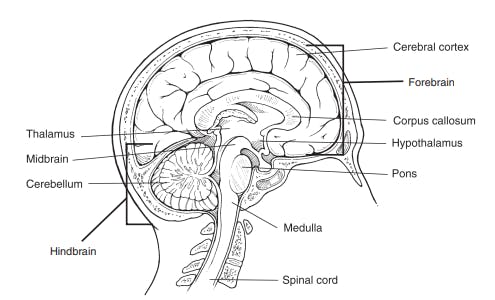AP Psychology Unit 2 Notes: Biological Bases of Behavior
AP Psychology: Unit 2 Summary
The second AP Psychology unit shifts the focus from the history of psychology and research methods to the specific topic of the relationship between biology and behavior. The first part of the unit summarizes the structure and function of different parts of the brain (including neural anatomy and processes). The unit continues with a brief overview of how the biological systems of genetics and the endocrine system influence thinking and behavior. The unit ends by summarizing the application of biological psychology research to the specific topic of states of consciousness: how brain chemistry and other biological systems relate to sleep, dreams, and psychoactive drugs.
AP Psychology: Unit 2 Key Terms & People
Below, we describe some of the Unit 2 key terms and people you should review ahead of the AP Psychology exam.
Neurons: Individual nerve cells. These cells make up our entire nervous system, from the brain to the neurons that fire when you stub your toe. Every neuron is made up of discrete parts.
Neurotransmitters: Chemicals contained in terminal buttons that enable neurons to communicate. Neurotransmitters fit into receptor sites on the dendrites of neurons like a key fits into a lock.
Afferent neurons: Take information from the senses to the brain. (You can think of afferent nerves as taking information in at the brain.)
Efferent neurons: Take information from the brain to the rest of the body. (You can think of efferent nerves as carrying information that exits the brain.)
Central nervous system: The central nervous system (CNS) consists of our brain and spinal cord—all the nerves housed within bone (the skull and vertebrae).
Peripheral nervous system: The peripheral nervous system (PNS) consists of all the other nerves in your body—that is, all the nerves not encased in bone. The peripheral nervous system is divided into two categories: the somatic and the autonomic nervous systems.
Computerized axial tomography (CAT or CT) scan: Is a sophisticated X-ray. The CAT scan uses several X-ray cameras that rotate around the brain and combine all the pictures into a detailed three-dimensional picture of the brain’s structure. Note that the CAT scan can show only the structure of the brain, not the functions or the activity of different brain structures.
Magnetic resonance imaging (MRI): An MRI uses magnetic fields to measure the density and location of brain material. Since the MRI does not use X-rays like the CAT scan does, the patient is not exposed to carcinogenic radiation. Like the CAT scan, the MRI gives doctors information about only the structure of the brain, not the function.
Cerebral cortex: When most people think of the human brain, they think of and picture the cerebral cortex. The gray wrinkled surface of the brain is actually a thin (0.039-inch [1-mm]) layer of densely packed neurons. This layer covers the rest of the brain. When we are born, our cerebral cortex is full of neurons (more than we have now, actually) but the neurons are not yet well connected. As we develop and learn, the dendrites of the neurons in the cerebral cortex grow and connect with other neurons.

Hemispheres: The cerebral cortex is divided into two hemispheres: left and right. The hemispheres look like mirror images of one another, but they exert some differences in function. The left hemisphere gets sensory messages and controls the motor function of the right half of the body. The right hemisphere gets sensory messages and controls the motor function of the left half of the body.
Endocrine system: This is a system of glands that secrete hormones that affect many different biological processes in our bodies. The endocrine system is controlled in the brain by the hypothalamus.
Circadian rhythm: During a 24-hour day, our metabolic and thought processes follow a certain pattern. Some of us are more active in the morning than others, some of us get hungry or go to the bathroom at certain times of day, and so on. Part of our circadian rhythm is our sleep cycle.
REM: After a period of time in delta sleep, our brain waves start to speed up and we go back through stages 3 and 2. However, as we reach stage 1, our brain produces a period of intense activity, our eyes dart back and forth, and many of our muscles may twitch repeatedly. This is REM—rapid eye movement.
Sigmund Freud: Sigmund Freud considered dreams an important tool in his therapy. Freudian psychoanalysis emphasizes dream interpretation as a method to uncover the repressed information in the unconscious mind. Freud said that dreams were wish fulfilling, meaning that in our dreams we act out our unconscious desires.
Depressants: Depressants slow down the same body systems that stimulants speed up. Alcohol, barbiturates, and anxiolytics (also called tranquilizers or antianxiety drugs) like Valium are common depressants